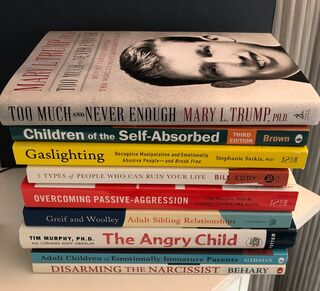President Donald Trump
Psychological Concepts in Mary Trump's Memoir
Keep a handy dictionary as you read this bestseller.
Posted July 13, 2020 Reviewed by Lybi Ma
Since November 2016, there’s no shortage of no-holds-barred books revealing executive branch turmoil and a polarized populace. I’ve eschewed most, favoring a novel to escape it all, but my work requires that I read about dealing with difficult personalities.
Too Much and Never Enough: How My Family Created the World’s Most Dangerous Man lays bare destructive relationships from what author Mary L. Trump, Ph.D., describes are born of tragic abuse, neglect, and intergenerational manipulation.1

This week, it’s on top of the book pile regarding fractious behavior while not imposing politics but delivering intimate knowledge of the family emotional process, complete with who was cut off from whom, where enmeshment and enabling occurred, and first-hand accounts of holidays, weddings, and funerals—all the usual places where dysfunction reveals itself.
Understanding family systems is game-changing. I had hoped that Dr. Trump would weave systems theory into her text though she uses psychological nomenclature and the Diagnostic and Statistical Manual of Mental Disorders (DSM-5) when she writes that focusing solely on all nine narcissistic criteria misses the mark.2
“A case could be made,” Dr. Trump writes, “…for antisocial personality disorder, which in its most severe form is generally considered sociopathy.” She posits comorbidities, including dependency as she dispels the self-made mogul myth, and possibly, an undiagnosed learning disability.
While not mentioning a three-generation genogram, Mary Trump does that necessary look back in understanding family—one’s own era, her father and his siblings, plus grandparents, with anecdotes, all rich in detail. Unless otherwise indicated, quotes come from Dr. Trump’s writing.
Here are concepts—serving as a psychological or family systems dictionary—if you read Too Much and Never Enough.
Personality Disorder—Per the DSM-5 when traits are inflexible, maladaptive (causing significant impairment or distress) and deviate markedly from one’s cultural expectations—when they meet the required number of diagnostic criteria—they qualify as a disorder. Typically appearing in early adulthood, they endure as a pattern and remain over time.3
Sociopathy—Antisocial behavior, often criminal, in those who lack a sense of moral responsibility or social conscience.4
Sociopathy afflicts “as much as 3 percent of the population,” Dr. Trump writes, "75 percent of which are men," and includes: "lack of empathy, facility for lying, indifference to right and wrong, abusive behavior, and lack of interest in the rights of others." Having a sociopath as a parent, if there aren’t others to mitigate the effects, severely disrupts how children "regulate their emotions and engage in the world."
Genogram—A diagram of multiple generations noting demographics, emotional patterns, and relationship bonds; e.g., if a marriage was happy or troubled, if a child was close to a parent or sibling or cut off. Particular symbols represent descriptions.5
Without the visual, Dr. Trump has pulled patterns from her memories and conversations, which serve the book well. “In order to get a complete picture,” she writes, “…we need a thorough family history.”
“The Cruelty Is the Point,” aptly sums up dependence upon patriarch Fred Trump whom the author says was absent from family life, lacked “real human feeling,” displayed "rigidity as a parent and husband," and believed “in a woman’s innate inferiority.”
Mirroring—A caregiver’s accurate reflection of a child’s expressed thoughts and feelings leading to acceptance and validation. Mirroring is crucial to child development and becomes internalized, allowing a child to enter adulthood with self-awareness.
Dr. Trump notes that “mirroring is the root of empathy” and being deprived of it resulted in “displays of narcissism, bullying, grandiosity.”
Attachment—A deep, enduring emotional bond between a young child and at least one primary caregiver so that the child develops normal social and emotional intelligence.
Mary Ainsworth, Mary Main, and Jude Cassidy, key researchers, distinguished three types of insecure attachments (avoidant, ambivalent, and disorganized). A securely attached parent meets a child’s physical and emotional needs. If a child whines, a secure parent encourages patience and manners, yet an insecure parent, caught up in his own problems, misses these opportunities. The child ups the ante and becomes louder, more demanding. If the parent doesn’t redirect and teach but effectively squashes the child’s communication attempts, this child’s needs may shut off, go silent or fester.6
Mary L. Trump, understanding her grandmother (Mary Anne) grew up in an “often inhospitable environment in the early 1910s,” states that she didn’t attend to her children when they needed her and that she was prone to martyrdom, even after she recovered from serious postpartum complications after her last child.
Her uncles, Dr. Trump writes, were very young (toddler and infant) and missed their mother. “The greater their distress, however, the more Fred rebuffed them.”
Any demand sparked household tension. “By engaging in behaviors that were biologically designed to trigger soothing, comforting responses from their parents, the little boys instead provoked their father’s anger or indifference when they were most vulnerable.” Needing equating to humiliation.
Mary Trump has written a sobering look at her clan that incorporates her professional knowledge quite well. Most every graduate program requires the look into one’s own family of origin. Whether this reflection began long ago, Dr. Trump expounds upon concepts such that readers become the recipients of her hard-won wisdom.
More of the book and how the average person can apply this in Part Two:
Mary Trump's Family Journey May Spark Your Own
Copyright @ 2020 by Loriann Oberlin. All rights reserved.
References
1. M. L. Trump, Too Much and Never Enough: How My Family Created the World’s Most Dangerous Man (New York: Simon & Schuster, 2020). https://tinyurl.com/Mary-Trump-Book
2. Diagnostic and Statistical Manual of Mental Disorders (fifth edition). (Arlington, VA: American Psychiatric Publishing, 2013). https://tinyurl.com/Diag-Stat-Manual
3. Diagnostic and Statistical Manual of Mental Disorders (fifth edition). (Arlington, VA: American Psychiatric Publishing, 2013). https://tinyurl.com/Diag-Stat-Manual
4. Dictionary.com, https://www.dictionary.com/browse/sociopath
5. I. Galindo, E. Boomer, and D. Reagan, A Family Genogram Workbook (2016). https://tinyurl.com/Genogram-Workbook
6. T. Murphy and L. Oberlin, Overcoming Passive-Aggression: How to Stop Hidden Anger from Spoiling Your Relationships, Career and Happiness (Boston: DaCapo Press, 2016). https://tinyurl.com/Overcoming-Passive-Aggression




